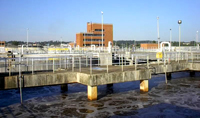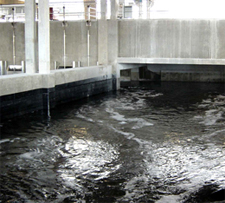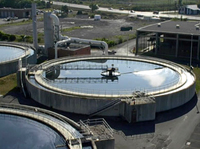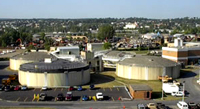|
Metropolitan Syracuse (Metro)
Permits and Reports
(Effective July 1,2017 to June 30, 2022. This SPDES permit has been extended under the State Administrative Procedures Act.)
Tour Metro - Click here for the Metro tour guide.
The Metropolitan Syracuse Wastewater Treatment Plant (Metro) provides high quality treatment for
270,000 people and many industrial and commercial
customers in the City of Syracuse and some areas
outside the city in Onondaga County.
Metro treats an average of 84 million gallons per day.
Full secondary and tertiary treatment can be provided
for up to 126 million gallons per day. Metro has a total
hydraulic capacity of 240 million gallons per day
during wet-weather events such as rainstorms.

LINK: Hi-Res Version of Metro Overview
Wastewater Treated By Metro
Wastewater reaches Metro from a number of sources. The
largest is the Main Interceptor Sewer (MIS) that runs
north-south through nearly the center of Syracuse. The
MIS is 90-inch in diameter.
The Harbor Brook Pump Station contributes 30 million
gallons per day (MGD) to Metro. In addition, the Ley
Creek, Westside, and Liverpool pump stations convey
wastewater to Metro.
This influent enters a diversion structure that
can channel wastewater to either of the two
grit-removal facilities at Metro. An overflow
structure prevents any flooding at the treatment plant
in case of an emergency.
The first step in treating the sewage at Metro is the
removal of sizable objects. The wastewater flows through
large racks with spaced steel bars, and debris that
cannot fit through the spaces is caught on the racks.
This material is removed and disposed of.
 |
| Inside a Screen & Grit Facility. |
The wastewater next enters the grit chambers. Sand,
stones, and other small bits of solid waste are
removed there. Wastewater then flows through screens
where additional debris is removed.
Since water always flows downhill naturally, it is
easier to manage the wastewater if it flows by gravity
through Metro. The low-lift pump station raises the
incoming wastewater to such a level. The station has
five centrifugal pumps rated for 600 horsepower. The
pumps' speeds vary depending on the amount of
wastewater entering the plant. Each pump has the
capacity to handle 60 MGD—for a total of 240 MGD for
the low lift pump station.
The wastewater is discharged from the lift station to a
90-inch diameter force main that is 820 feet long.
At an average rate of 84 MGD, the flow is 2.2 ft/sec.
The wastewater is treated in stages—three times—before it is disinfected and discharged to Onondaga Lake. The stages are named primary, secondary,
and tertiary treatment.

Treatment starts in the primary clarifiers. They
are 135 ft in diameter, have a 10-ft side wall depth,
and can hold 1.07 million gallons.
In the first stage of, treatment process, solid
particles settle from the water. The wastewater's
velocity is slowed to permit the solids to settle. The
solid material falls into a trough at the bottom of a
tank. This mixture of solids and wastewater is pumped
to thickeners where the amount of water is
substantially reduced prior to further treatment via anaerobic digestion.
At this stage, floatable materials such as oils and grease are skimmed from the
surface of the clarifiers.
Bypass Flows
After primary treatment, any flow greater than 66
MGD/side (126 MGD total) is sent to the by-pass
chlorine contact tanks for disinfection. This facility
consists of two rectangular contact tanks (31 ft by 100 ft by
20 ft deep). If flow is 126 MGD, the contact time is
13 minutes.
Secondary Treatment
 |
| Aeration area |
The next stage of wastewater treatment provides a
controlled environment where bacteria come in contact
with the organic matter. An iron salt is added to
improve removal of phosphorus.
Aeration tanks mix the water and provide sufficient
contact time to decompose and the organic material and
allow it to coalesce for later removal from the water.
Metro has eight aeration tanks, 100 ft by 130 ft by
14.2 ft deep. Each holds 1.4 million gallons.
Secondary clarifiers hold the water to permit the
solids to settle. In this process, the biosolids are
moved to the center of the tank, and most of this
material is pumped to the thickeners. Each of the four
secondary clarifiers are 170 ft square by 11 ft deep.
They each hold 1.83 million gallons.
Treatment is not yet finished, however.
Tertiary Treatment
In January 2004, Onondaga County WEP put into service a new
pump station that will pump secondary-treated
wastewater to the tertiary process. Known as the SEPS
(Secondary Effluent Pump Station), it now pumps a peak
flow of 126 MGD to a new state-of-the-art tertiary
treatment process for year-round removal of ammonia.

Removing Ammonia
 |
| Effluent flow through the BAF cross gallery |
Ammonia in high concentrations can be lethal to juvenile fish and other aquatic animals. The
concentration of ammonia discharged from Metro has been reduced significantly, after startup of the biological aerated filter system (BAF) in January of 2004.
This BAF process
was developed by I. Krüger, Inc. referred to as the Biostyr process.
At Metro, the BAF process consists of eighteen individual
cells, each with a capacity of about 273,000 gal. The
cells are filled with billions of polystyrene beads
that are 0.14 inch in diameter. These beads provide a
huge surface area on which grow nitrifying bacteria,
and these bacteria convert ammonia to nitrate and
nitrite. The BAF process lowers ammonia below 1 mg/L.
Phosphorus is a nutrient that aids algae growth.
In limited quantities, algae is beneficial, but in
high concentrations it can cause many problems. An
over-abundance of algae is unsightly, leads to odors,
and, most importantly, when it dies it sinks to the
bottom of the lake and decomposes using precious
dissolved oxygen in the process. The oxygen is
critical to fish and other aquatic life.
Thus, more phosphorus leads to more algae—which leads to
less oxygen.
A high rate flocculated settling (HRFS) process called Actiflo, developed by I. Krüger Inc., is used at Metro to further remove phosphorus remaining after primary and secondary treatment. Effluent from the BAF enters the first tank of the HRFS system where coagulants are injected. The coagulant adheres to phosphorus molecules causing them to form larger flocs or “clumps” of particles. In a second tank, micro-sand is added to the effluent containing the coagulated flocs. In a third tank mixing is provided which further increases the floc size. Settling occurs in the fourth tank where the floc , ballasted by the micro-sand, settles by gravity and is collected as a concentrated sludge . The micro-sand is then separated from the concentrated sludge for reuse and the remaining phosphorus-rich sludge is pumped to the biosolids handling facilities at the plant. The effluent from this HRFS technology allows the county to meet the phosphorus limit of 0.10 mg/l (measured as a 12-month rolling average).
As with ammonia, the concentration of phosphorus
in Metro's discharge has declined over the
past several years because of Onondaga County's operating changes and
treatment efforts.
Disinfection of the Discharge Water
Following the HRFS process, the treated water passes
through an ultraviolet light disinfection system. UV
light provides a chemical-free way to disinfect
wastewater by altering the genetic material in
bacteria, viruses, and other micro-organisms so that
they no longer can reproduce. UV light provides an
environmentally safe way to disinfect wastewater.
The UV system consists of 308 high-intensity
germicidal lamps that are submerged in an open
channel. As the wastewater flows past the lamps, the
micro-organisms are exposed to a lethal dose of UV
energy. The intensity of the UV lamps can can be
varied to deliver between 840 and 2400 watts.

Biosolids
The biosolids and associated liquid—products
separated through primary, secondary, and tertiary
treatment—are thickened to reduce the liquid content. A
polymer is added to the mixture to promote settling of
the solids.
The three thickening tanks are 65 ft in diameter and
12 ft deep. Each holds 298,000 gallons.
The thickened biosolids are kept heated between 90-95°F
and mixed. A byproduct of this process is methane gas,
which is used to fuel the boilers that heat the
digesters and the buildings at Metro.
The plant has three primary digesters that are 100 ft
in diameter with walls 27.5 ft high. They each hold
1.6 million gal.
A fourth digester, fitted with a floating roof cover, primarily serves as biogas storage but does provide for additional, though limited, digestion of biosolids.
The digested biosolids are treated with a polymer to
promote further separation of solids and the water.
The biosolids are then pressed on a belt filter to produce
a cake. |











